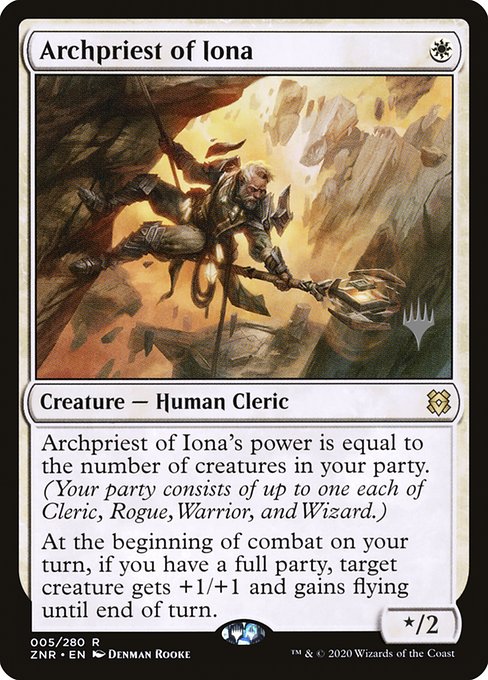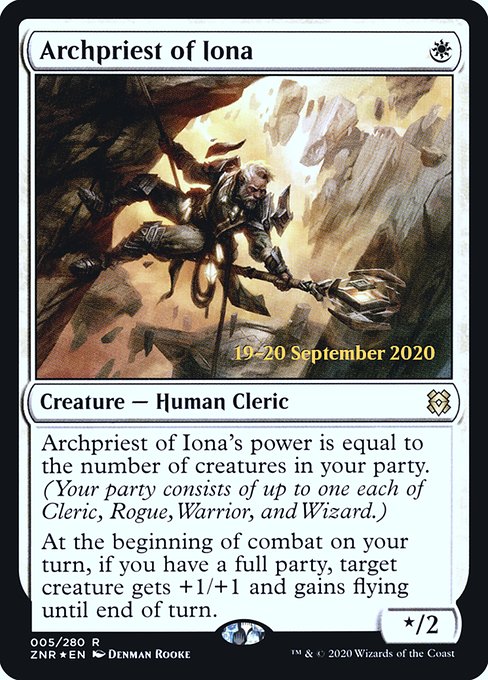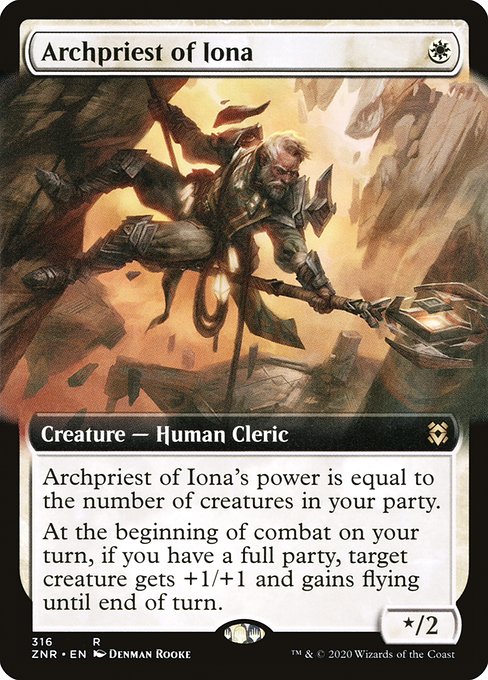Archpriest of Iona
Creature — Human Cleric
Archpriest of Iona's power is equal to the number of creatures in your party. (Your party consists of up to one each of Cleric, Rogue, Warrior, and Wizard.)
At the beginning of combat on your turn, if you have a full party, target creature gets +1/+1 and gains flying until end of turn.
At the beginning of combat on your turn, if you have a full party, target creature gets +1/+1 and gains flying until end of turn.
*/2
standard
future
historic
gladiator
pioneer
explorer
modern
legacy
pauper
vintage
penny
commander
brawl
alchemy
paupercommander
duel
oldschool
premodern
Rulings
Once the target creature gets +1/+1 and gains flying, it keeps those bonuses even if you no longer have a full party later in the turn.
The last ability won't trigger at all if you don't have a full party as your combat phase begins. It won't grant +1/+1 or flying if you don't have a full party as it resolves. The number of creatures in your party may change between these times, however.
Archpriest of Iona's power is constantly updated as the number of creatures in your party changes. If Archpriest of Iona is on the battlefield, it will consider itself as a Cleric.
The ability that defines Archpriest of Iona's power applies in all zones, not just the battlefield.
Some cards refer to you having a “full party.” This is true if the number of creatures in your party is four.
An ability referring to the number of creatures in your party gets a number from zero to four. Such abilities never ask which creatures are in your party, and you never have to designate specific creatures as being in your party. You can't choose to exclude creatures from this count to lower the number.
To determine “the number of creatures in your party,” check whether you control a Cleric, whether you control a Rogue, whether you control a Warrior, and whether you control a Wizard. The number is the total number of those checks to which you answered yes. Each creature you control can be counted for only one of those checks.
If a creature has more than one party creature type, and there are multiple ways to count that creature that could result in a different number of creatures in your party, the highest such number is used. For example, if you control a Cleric and a Cleric Wizard, the number of creatures in your party is two. You can't choose to have it be just one by counting the Cleric Wizard first as a Cleric.
The last ability won't trigger at all if you don't have a full party as your combat phase begins. It won't grant +1/+1 or flying if you don't have a full party as it resolves. The number of creatures in your party may change between these times, however.
Archpriest of Iona's power is constantly updated as the number of creatures in your party changes. If Archpriest of Iona is on the battlefield, it will consider itself as a Cleric.
The ability that defines Archpriest of Iona's power applies in all zones, not just the battlefield.
Some cards refer to you having a “full party.” This is true if the number of creatures in your party is four.
An ability referring to the number of creatures in your party gets a number from zero to four. Such abilities never ask which creatures are in your party, and you never have to designate specific creatures as being in your party. You can't choose to exclude creatures from this count to lower the number.
To determine “the number of creatures in your party,” check whether you control a Cleric, whether you control a Rogue, whether you control a Warrior, and whether you control a Wizard. The number is the total number of those checks to which you answered yes. Each creature you control can be counted for only one of those checks.
If a creature has more than one party creature type, and there are multiple ways to count that creature that could result in a different number of creatures in your party, the highest such number is used. For example, if you control a Cleric and a Cleric Wizard, the number of creatures in your party is two. You can't choose to have it be just one by counting the Cleric Wizard first as a Cleric.
Rulings
Once the target creature gets +1/+1 and gains flying, it keeps those bonuses even if you no longer have a full party later in the turn.
The last ability won't trigger at all if you don't have a full party as your combat phase begins. It won't grant +1/+1 or flying if you don't have a full party as it resolves. The number of creatures in your party may change between these times, however.
Archpriest of Iona's power is constantly updated as the number of creatures in your party changes. If Archpriest of Iona is on the battlefield, it will consider itself as a Cleric.
The ability that defines Archpriest of Iona's power applies in all zones, not just the battlefield.
Some cards refer to you having a “full party.” This is true if the number of creatures in your party is four.
An ability referring to the number of creatures in your party gets a number from zero to four. Such abilities never ask which creatures are in your party, and you never have to designate specific creatures as being in your party. You can't choose to exclude creatures from this count to lower the number.
To determine “the number of creatures in your party,” check whether you control a Cleric, whether you control a Rogue, whether you control a Warrior, and whether you control a Wizard. The number is the total number of those checks to which you answered yes. Each creature you control can be counted for only one of those checks.
If a creature has more than one party creature type, and there are multiple ways to count that creature that could result in a different number of creatures in your party, the highest such number is used. For example, if you control a Cleric and a Cleric Wizard, the number of creatures in your party is two. You can't choose to have it be just one by counting the Cleric Wizard first as a Cleric.
The last ability won't trigger at all if you don't have a full party as your combat phase begins. It won't grant +1/+1 or flying if you don't have a full party as it resolves. The number of creatures in your party may change between these times, however.
Archpriest of Iona's power is constantly updated as the number of creatures in your party changes. If Archpriest of Iona is on the battlefield, it will consider itself as a Cleric.
The ability that defines Archpriest of Iona's power applies in all zones, not just the battlefield.
Some cards refer to you having a “full party.” This is true if the number of creatures in your party is four.
An ability referring to the number of creatures in your party gets a number from zero to four. Such abilities never ask which creatures are in your party, and you never have to designate specific creatures as being in your party. You can't choose to exclude creatures from this count to lower the number.
To determine “the number of creatures in your party,” check whether you control a Cleric, whether you control a Rogue, whether you control a Warrior, and whether you control a Wizard. The number is the total number of those checks to which you answered yes. Each creature you control can be counted for only one of those checks.
If a creature has more than one party creature type, and there are multiple ways to count that creature that could result in a different number of creatures in your party, the highest such number is used. For example, if you control a Cleric and a Cleric Wizard, the number of creatures in your party is two. You can't choose to have it be just one by counting the Cleric Wizard first as a Cleric.
Your collection? Your decks?
Want to manage your collection and/or create decks?
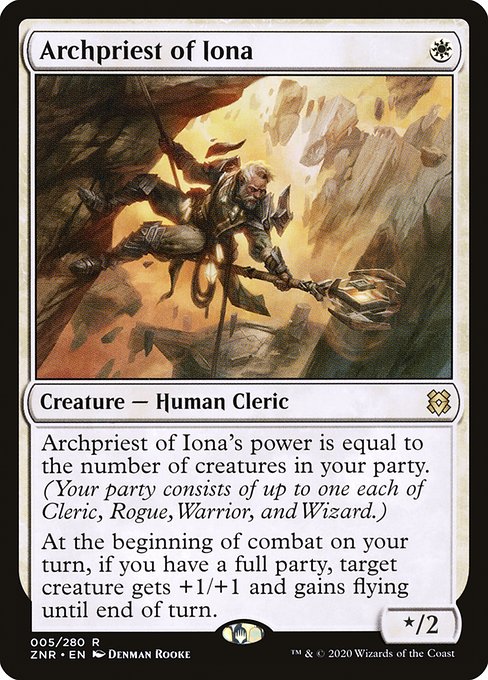

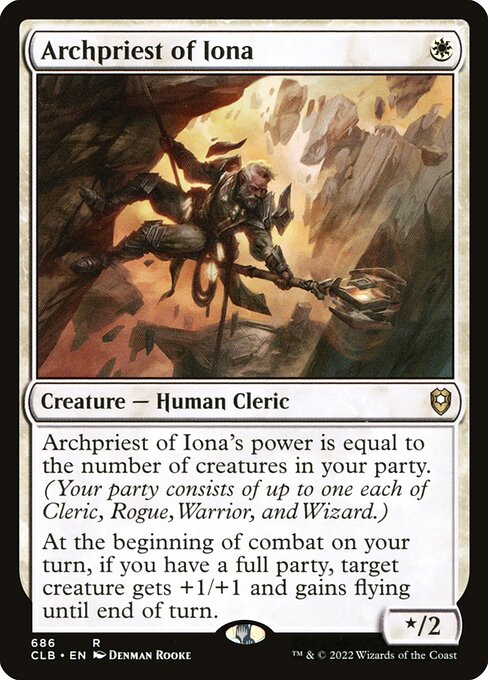
 0
0
 0.14€
0.14€
